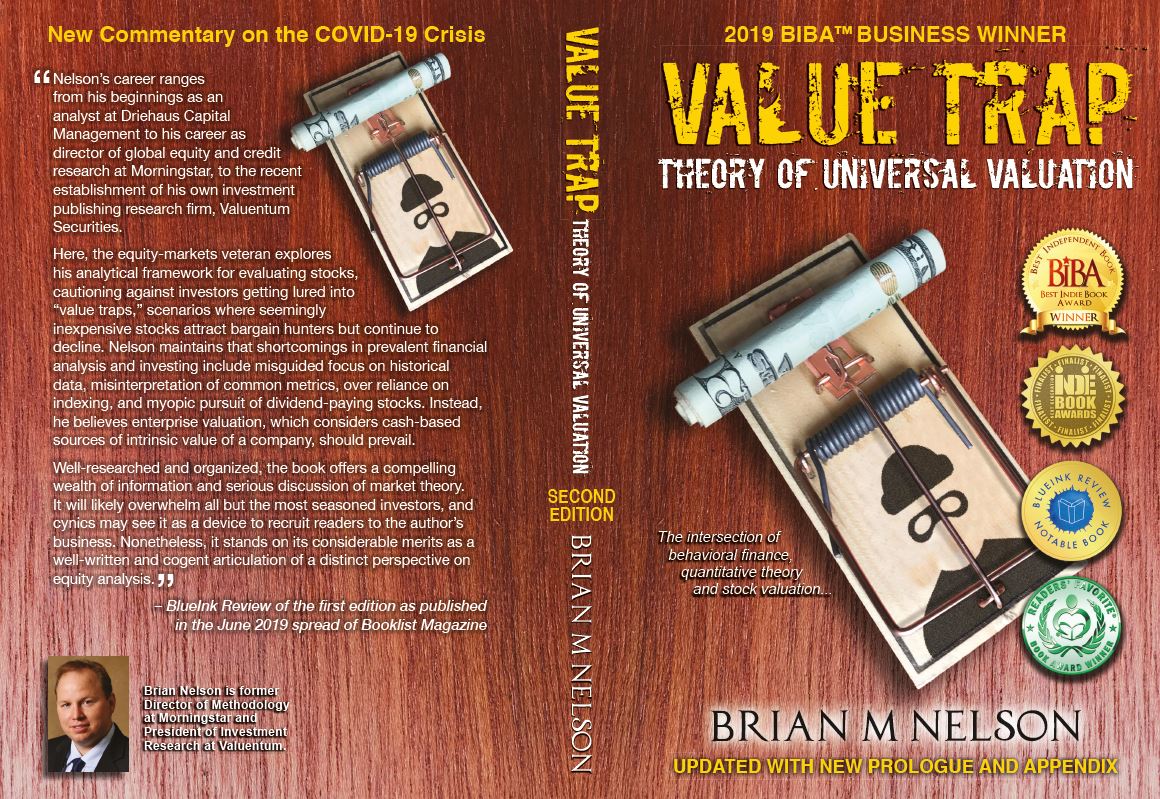Member LoginDividend CushionValue Trap |
High Yield Dividend Income Investing Is Not as Easy as Chasing the Highest Yield
publication date: Jul 3, 2024
|
author/source: Brian Nelson, CFA
 Dear members: Dear members:The skills to successfully invest for long-term capital gains or long-term dividend growth are much different than those required for generating high yield dividend income. Income investing is a much different proposition. However, the skills do center on a similar equity evaluation process, but one that requires an acknowledgement and heightened awareness of considerably greater downside risks. Income investing, or high yield dividend income investing, should at times be considered among the riskiest forms of investing, as many high dividend-yielding securities tend to trade closer to the characteristics of junk-rated bonds than they do most net cash rich and free cash flow generating powerhouses that we like so much in the Best Ideas Newsletter portfolio (1) and Dividend Growth Newsletter portfolio (2).
---
The dividend yield, itself, often says a lot about a company's financial health and the magnitude of risk corresponding to the ability of the company to keep paying the dividend at its existing annual rate. Let's think about this logically. In a world where CDs are yielding ~5%, for a common equity's yield to grow north of, let's say 8%, it generally speaks more to the risk of the sustainability of the payout than any abnormally large risk-adjusted income opportunity. Not all dividends are created equal. Just like you wouldn't expect to find $20 bills blowing around to pick up on the busy streets downtown, one shouldn't expect an 8% yielder to have the same risks to the dividend as a 2-3% dividend yielder.
---
The stock market is definitely not efficient (it failed to adjust rapidly to new information regarding COVID-19 in early February 2020, as just one example), but it is not that inefficient to misprice risk to the point where investors should view that 8% yielder in any equivalent manner as a tried-and-true 2%-3% dividend yielder with substantial dividend growth prospects. The risk that the 8% yielder may cut its dividend payment, for example, could be multiple times the risk of that 2-3% yielder. Intrinsic value considerations aside, if risk were the same between the two securities, the market might price that 8% yielding equity closer to the 2-3% yield range and drive its price higher. That 8% yielder is trading at a depressed price for a reason: its risk is comparatively higher.
---
Let's get back to which similar equity evaluation process I noted in the first paragraph (3). You guessed it: enterprise valuation (i.e. the discounted cash flow method). Where enterprise valuation 1) helps to identify underpriced equities with strong cash-based sources of intrinsic value (i.e. net cash and future expected free cash flows) to combine with technical/momentum indicators for long-term capital appreciation potential via a heightened probability of market price to estimated fair value convergence and 2) highlights net cash rich and strong expected free cash flow payers that can comfortably cover their future dividend growth aspirations for years to come, as evidenced by their lofty Dividend Cushion ratios, it also 3) identifies the key risks associated with investing for income in the high dividend yield arena.
---
In most cases, and as implied thus far, high dividend-yielding stocks have substantially higher financial risk than the average company on the market. For example, many yielders north of 5%-6% tend to have large net debt positions weighing down their intrinsic value, and/or modestly cover their future expected dividend payments with future expected traditional free cash flows. The combination of a generally leveraged balance sheet and meager traditional free-cash-flow coverage of the dividend translates into a very weak Dividend Cushion ratio. We measure the Dividend Cushion ratio by forecasting future expected free cash flows and comparing them to a company's expected dividend payments. We also consider the net balance sheet position of the equity in the calculation. All else equal, a company with a large net cash position and strong expected future free cash flows above and beyond its future dividend growth expectations has materially better dividend health than a company with a large net debt position that fails to cover its future expected dividends with traditional free cash flow.
---
A number of high dividend yielding equities may also be very capital-market dependent (i.e. REITs, MLPs, overleveraged cyclicals, and the like), meaning they depend heavily on the capital markets to be widely open and available to keep paying their dividends/distributions, where on the other hand, entities such as Apple (AAPL) or Microsoft (MSFT) that have huge net cash positions and strong expected future free cash flows may not care much if the markets even closed for the next 5 years. This is partly why we like net cash rich and strong free cash flow generating enterprises so much. They don't have much capital-market dependency and credit risk, the absence of which helps to support their equity prices during times of crises, as was revealed during the COVID-19 swoon. It's no surprise to us why large cap growth has dominated returns the past few years. A large cap growth ETF, for example, is up over 140% during the past five years on a price-only basis.
---
Where large cap growth has performed incredibly well, many REITs and MLPs suffered tremendously during the Great Financial Crisis, and during the COVID-19 crisis, due to their capital-market dependency and credit risk. Over the past five years, for example, on a price-only basis, a broad-based REIT ETF is down ~4%, while a broad-based MLP ETF is down ~2%, relative to an S&P 500 that is up 85%+. It is often very rare to find a REIT that covers its future expected dividends with traditional free cash flow, while MLPs have just started to do a better job covering their distributions with traditional free cash flow. To seemingly add to investor confusion, these two groups have come up with their own industry-specific measures to communicate to investors: adjusted funds from operations (AFFO) for REITs and distributable cash flow (DCF) for pipeline MLPs, not to be confused with discounted cash flow.
---
However, investors should be aware that, while management teams may say their entities have hefty dividend or distribution coverage on the basis of these (non-GAAP) industry-specific metrics, the astute high yield dividend income investor should always assess balance sheet health (net cash vs. net debt) and use traditional free cash flow in the evaluation process, as measured by cash flow from operations less all capital spending. Focusing on traditional free cash flow saved Valuentum members from the impending collapse of pipeline MLP equities in 2015, and the pipeline industry is just starting to recover as traditional free cash flow generation improves. There is truly nothing better than a focus on business model (competitive advantage) analysis, balance sheet (net cash or net debt) analysis, and future free cash flow assessments. You can consider the industry-specific information provided by management teams, but to a large degree, it can sometimes be misleading.
---
Searching for income within high dividend yield investments therefore isn't always easy. Almost every pipeline MLP, for example, said that its distribution was covered nicely heading into the collapse of 2015/2016. There have been dozens upon dozens of pipeline MLP cuts since then, despite such reassurances. The capital-market dependency risks of REITs are not to be overlooked either, as many have had to frequently raise equity to keep their payouts on the up and up. While we have generally favored REITs over MLPs in the past, all else equal, we generally prefer high dividend paying corporates over both of these business structures. We can't always find a high dividend yielding competitively-advantaged corporate with substantial net cash and strong expected future free cash flows, but we want to get as close to those dynamics in our favorite high dividend-yielding income payers as possible.
---
Because capital-market dependency risk is so important to evaluate, we generally prefer high dividend-yielding companies that have investment-grade credit quality, as many generally won't have our preferred outsize net cash positions on the balance sheet. An investment-grade credit rating generally means that when the going gets tough, the entity will be able to raise debt at reasonable rates, if need be, to offset liquidity risk that may arise from having to pay out such a large dividend/distribution in tough times. Capital-market dependent junk-rated credits, however, may be heavily exposed to an "avalanche effect" under crisis conditions, whereupon they may be forced to raise equity capital at depressed prices, impairing intrinsic value at the same time the dividend is threatened. High yield dividend investors should pay very, very close attention to a company's corporate credit rating (BBB and above, but preferably A rated) and its equity price movements (much more so than in other investment styles), as equity is also a source of capital to preserve the payout.
---
After considering just how much the entity is in investment-grade territory with respect to its credit, an evaluation of the cash flow statement should come next. Many pipeline MLPs have only just started to cover their distributions with future expected traditional free cash flow, and perhaps only a rare few in the REIT space do. Our favorite REITs generally operate within the data center and self-storage arenas. Corporates, however, often have a greater capacity to generate traditional free cash flow in excess of future expected dividends paid. Let's use an example. Though a high dividend-yielding corporate such as Altria (MO) may have a hefty and ominous net debt position, it covers its future expected dividend payments nicely with expected free cash flows. Altria also has an investment-grade balance sheet (A3/BBB/BBB), and given its competitively-advantaged business model and ~8.5% annualized dividend yield at current prices, it might make the cut for the high dividend yield income investor's portfolio. In fact, Altria is a holding in our High Yield Dividend Newsletter portfolio (4).
---
Without a doubt, high yield dividend income investing is not easy, and it's definitely not as simple as selecting the highest dividend yielders and taking management's word that things will be okay. Investors can be blindsided by a double-whammy occurring as a result of the company cutting its outsize dividend payment while having to raise equity capital at depressed prices as a result of most income investors selling hand over fist (i.e. the avalanche effect). However, a focus on a firm's business model (competitive advantages), credit rating (preferring healthy investment-grade entities), and future expected traditional free cash flow coverage of the dividend, while generally avoiding entities with considerable capital-market dependency and credit risk could lead many investors to some very nice high-yielding dividend paying equities today.
---
We hope you found this article helpful!
---
(1) The Best Ideas Newsletter portfolio: https://www.valuentum.com/articles/20120809_3
(2) The Dividend Growth Newsletter portfolio: https://www.valuentum.com/articles/20120809_4
---
Kind regards,
---
Brian Nelson, CFA
President, Investment Research
Valuentum Securities, Inc.
brian@valuentum.com
---
It's Here!
The Second Edition of Value Trap! Order today!
 -----
---
Tickerized for holdings in the SCHH and AMZA. A version of this article appeared on our website September 2020.
---
Brian Nelson owns shares in SPY, SCHG, QQQ, DIA, VOT, RSP, and IWM. Valuentum owns SPY, SCHG, QQQ, VOO, and DIA. Brian Nelson's household owns shares in HON, DIS, HAS, NKE, DIA, RSP, SCHG, QQQ, and VOO. Some of the other securities written about in this article may be included in Valuentum's simulated newsletter portfolios. Contact Valuentum for more information about its editorial policies. Valuentum members have access to our 16-page stock reports, Valuentum Buying Index ratings, Dividend Cushion ratios, fair value estimates and ranges, dividend reports and more. Not a member? Subscribe today. The first 14 days are free. |


0 Comments Posted Leave a comment